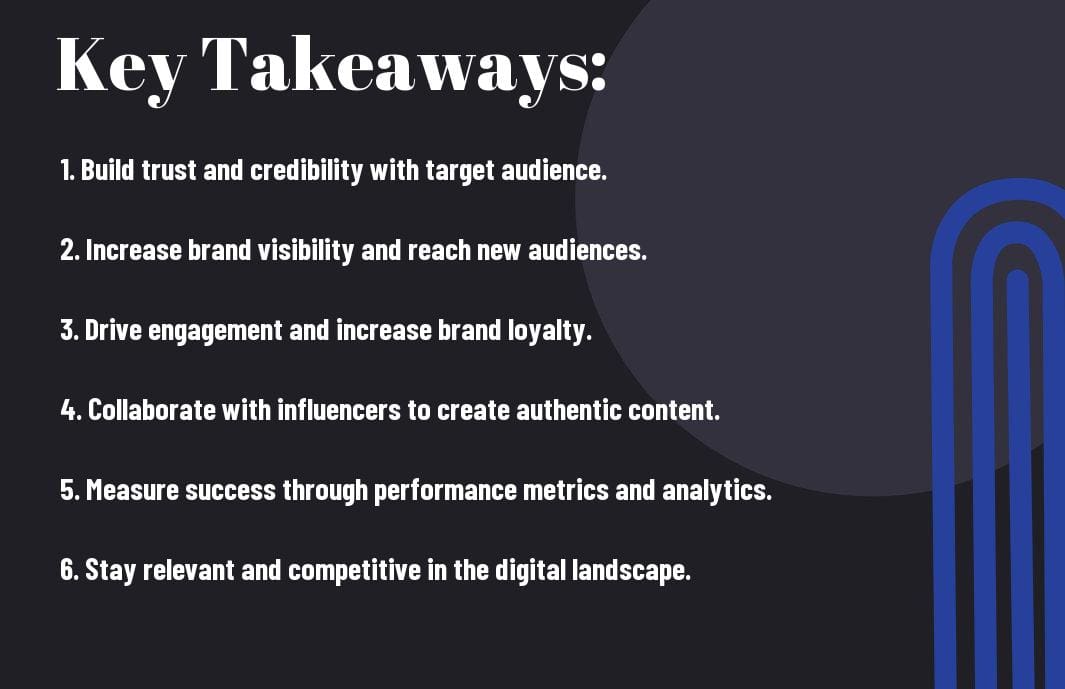Just imagine being able to reach millions of potential customers with a single post. That is the power of influencer marketing. In today’s digital age, influencer marketing has become a vital strategy for brands looking to boost their online presence, reach a targeted audience, and drive sales. By partnering with influencers who have a large and engaged following on platforms like Instagram, YouTube, and TikTok, brands can leverage their influence to increase brand awareness and credibility.
Key Takeaways:
- Increased Reach: Influencer marketing allows your brand to reach a larger audience through the influencer’s followers and their engagement with the content.
- Builds Trust and Credibility: When an influencer promotes your brand, it helps build trust and credibility with their followers who see the influencer as a trusted source.
- Targeted Audience: Influencer marketing allows you to target specific audiences based on the influencer’s demographic, interests, and niche, maximizing the impact of your marketing efforts.

Understanding Influencer Marketing
Definition and Scope
Scope: Some companies are turning to influencer marketing as a way to reach a larger audience and increase brand awareness. This type of marketing involves partnering with individuals who have a strong online presence and a large following on social media platforms. Influencers have the power to sway the purchasing decisions of their followers, making them valuable assets for brands looking to expand their reach.
Types of Influencers
Understanding: Some types of influencers include celebrities, macro-influencers, micro-influencers, and nano-influencers. Celebrities have a massive following and can reach a broad audience, while macro-influencers have a slightly smaller following but still boast a significant reach. Micro-influencers have a more focused and engaged audience, and nano-influencers have a small but highly influential group of followers.
- Celebrities have a massive following and can reach a broad audience.
- Macro-influencers have a slightly smaller following but still boast a significant reach.
- Micro-influencers have a more focused and engaged audience.
- Nano-influencers have a small but highly influential group of followers.
- Knowing the differences between these types of influencers can help brands make informed decisions when developing their marketing strategies.
The success of influencer marketing campaigns relies heavily on the type of influencer chosen to represent the brand. Each type of influencer brings its unique advantages and drawbacks to the table. By understanding the differences between celebrities, macro-influencers, micro-influencers, and nano-influencers, brands can make informed decisions on which influencers align best with their marketing goals. Knowing the key characteristics of each type can help brands maximize the impact of their influencer partnerships.
| Types of Influencers | Description |
| Celebrities | Massive following, broad audience reach |
| Macro-influencers | Significant reach, slightly smaller following than celebrities |
| Micro-influencers | Focused, engaged audience |
| Nano-influencers | Highly influential small group of followers |
| Understanding the differences help in making informed decisions | Knowing the characteristics can maximize impact of influencer partnerships |
Aligning Influencers With Your Brand Values
Identifying Appropriate Influencer Partnerships
One of the first steps in a successful influencer marketing strategy is identifying appropriate influencers who align with your brand values. It’s crucial to research and vet potential partners to ensure that their content, values, and audience resonate with your brand. Look for influencers who have a genuine connection to your industry or niche and can authentically promote your products or services.
Collaborating with influencers who share your brand values can help you reach a more relevant and engaged audience, leading to higher conversion rates and increased brand loyalty. By selecting influencers whose values align with yours, you can create more authentic and effective partnerships that drive meaningful results for your brand.
Maintaining Authenticity and Trust
Your brand’s reputation is on the line when partnering with influencers, so maintaining authenticity and trust is paramount. Transparency is key in building credibility with your audience, so clearly disclose any paid partnerships or sponsored content. Additionally, ensure that influencers maintain their authentic voice and style while promoting your brand to avoid coming across as insincere.
This approach will help you establish a long-term relationship with your audience and build trust over time. When followers see that your brand aligns with values they care about and that influencer partnerships are genuine, they are more likely to engage with your content and convert into loyal customers.
Crafting an Effective Influencer Marketing Strategy
Setting Clear Objectives and Key Performance Indicators (KPIs)
One of the first steps in developing a successful influencer marketing strategy is to set clear objectives and key performance indicators (KPIs). This involves clearly defining what you want to achieve with your influencer partnerships, whether it’s increasing brand awareness, driving website traffic, or boosting sales. By establishing specific goals, you can effectively measure the success of your campaigns and make data-driven decisions for future initiatives.
Choosing the Right Platforms and Formats
Any effective influencer marketing strategy hinges on choosing the right platforms and formats to reach your target audience. Depending on your brand and objectives, you may find success on platforms like Instagram, YouTube, TikTok, or even through blogs and podcasts. It’s important to research where your target audience is most active and receptive to influencer content in order to maximize the impact of your campaigns.
Indicators such as engagement rates, click-through rates, and conversion rates can provide valuable insights into the effectiveness of your influencer marketing efforts. By closely monitoring these key performance indicators, you can identify what is working well and make adjustments to optimize your strategy for better results.
Implementing the Campaign
Negotiating Partnerships and Contracts
To ensure a successful influencer marketing campaign, it is crucial to effectively negotiate partnerships and contracts with the influencers you choose to collaborate with. This process involves discussing the scope of work, deliverables, timelines, and compensation. Clear communication is key to avoid any misunderstandings or conflicts down the line. It is vital to lay out expectations clearly and detail the terms of the agreement in a contract.
Content Creation and Collaboration
When working with influencers, it is important to work together on content creation to ensure that the material aligns with your brand and resonates with the influencer’s audience. Collaboration is key in this process, as influencers know their followers best and can provide valuable insights on what will be well-received. Authenticity is vital in influencer marketing, so allowing influencers creative freedom while guiding them towards your brand message is vital.
On the note of Content Creation and Collaboration, it’s important to establish a clear and open line of communication with the influencers. Providing them with guidelines and feedback throughout the process can help ensure the content produced aligns with your brand’s image and goals.
Measuring Impact and Success
Your influencer marketing campaign is only as effective as its impact and success can be measured. By tracking and analyzing key performance metrics, you can gain valuable insights into the effectiveness of your campaign and make informed decisions moving forward.
Analyzing Performance Metrics
When analyzing the performance of your influencer marketing campaign, it’s vital to focus on key metrics such as reach, engagement, conversions, and brand sentiment. Reach measures the number of people who have been exposed to your campaign through the influencer’s content. Engagement reflects how well your audience is interacting with the content, while conversions track the actions taken by the audience as a result of the influencer’s promotion. Additionally, monitoring brand sentiment can help gauge how the audience perceives your brand after the campaign.
Adapting and Optimizing Campaigns
An influencer marketing campaign should be a dynamic process that allows for adaptation and optimization based on real-time data and insights. By analyzing performance metrics throughout the campaign, you can identify what’s working well and what needs improvement. This feedback loop gives you the opportunity to make adjustments and optimize your campaign for better results.
To ensure the success of your influencer marketing efforts, it’s crucial to continuously monitor and analyze performance metrics, and be willing to adapt and optimize your campaigns based on the insights gained. This iterative process will help ensure that your brand’s message resonates with the audience and drives meaningful results.
The Ethics and Legalities of Influencer Marketing
Now, as influencer marketing continues to dominate the digital landscape, it is important for brands and influencers to be well-versed in the ethics and legalities surrounding this practice. Understanding the rules and regulations pertaining to influencer marketing can help both parties navigate this landscape effectively and responsibly.
Understanding Disclosure and Regulations
An important aspect of influencer marketing is the disclosure of paid partnerships and sponsored content. The Federal Trade Commission (FTC) has strict guidelines in place that require influencers to clearly disclose any paid partnerships or compensated content. Failure to do so can result in penalties for both the influencer and the brand. It is crucial for both parties to follow these guidelines to maintain transparency and trust with their audience.
Navigating Endorsements and Sponsorships
For brands and influencers engaging in influencer marketing, understanding the difference between endorsements and sponsorships is key. An endorsement involves an influencer promoting a product or service based on their personal preference, while a sponsorship implies a paid partnership where the influencer is compensated for promoting the brand. Brands and influencers must clearly communicate the nature of their relationship to avoid misleading their audience.
Another critical aspect to consider is the potential consequences of improperly handling endorsements and sponsorships. Failing to disclose a paid partnership or misrepresenting a sponsored post as a personal recommendation can damage the credibility of both the influencer and the brand, leading to loss of trust among their audience and potential legal ramifications. It is imperative for both parties to prioritize transparency and compliance with regulations to ensure the success and sustainability of their influencer marketing efforts.
Future Trends in Influencer Marketing
Once again, the landscape of influencer marketing continues to evolve, presenting new opportunities and challenges for brands looking to harness the power of influencers. As we look to the future, understanding the trends shaping this industry is necessary for staying relevant and competitive in the digital space.
The Role of Technology and Platforms
To stay ahead in the influencer marketing game, brands must leverage the latest technology and platforms to streamline their campaigns and reach a wider audience. With the rise of AI and data analytics, brands can now identify the most relevant influencers for their campaigns, track performance metrics in real-time, and optimize their strategies for maximum impact. Platforms such as Instagram, TikTok, and YouTube continue to dominate the influencer landscape, offering brands diverse opportunities to engage with their target demographic.
Predictions for Influencer Marketing Evolution
Technology will play a crucial role in shaping the future of influencer marketing. As AI and machine learning algorithms become more sophisticated, brands can expect to see a shift towards micro-influencers and nano-influencers who have highly engaged, niche audiences. This personalized approach will enable brands to create authentic connections with consumers and drive higher conversion rates. Additionally, the rise of virtual influencers and augmented reality experiences will provide new and innovative ways for brands to connect with their audience in the digital realm.
Marketing strategies will need to adapt to these changing trends, focusing on building long-term relationships with influencers rather than one-off partnerships. Brands that prioritize authenticity, transparency, and creativity in their influencer collaborations will stand out in a saturated market, gaining the trust and loyalty of their target audience.
Final Words
As a reminder, influencer marketing is a powerful tool for brands to reach new audiences, build credibility, and increase engagement. By leveraging the trust and influence that influencers have with their followers, brands can authentically connect with consumers on a more personal level. This marketing strategy has the potential to drive brand awareness, increase sales, and foster long-term relationships with customers. To learn more about how businesses can harness the power of social media and influencer marketing to reach new audiences, check out How can businesses harness the power of social media and influencer marketing to reach new audiences.
FAQ
Q: What is influencer marketing?
A: Influencer marketing is a form of marketing where brands collaborate with individuals who have a large and engaged following, known as influencers, to promote their products or services to a specific target audience.
Q: Why is influencer marketing beneficial for brands?
A: Influencer marketing is beneficial for brands because it allows them to reach a highly targeted audience, build trust with consumers, increase brand awareness, and drive sales through authentic recommendations from influencers.
Q: How do you measure the success of influencer marketing campaigns?
A: The success of influencer marketing campaigns can be measured through key performance indicators (KPIs) such as engagement rates, reach, click-through rates, conversions, and return on investment (ROI).
Q: How do you find the right influencers for your brand?
A: To find the right influencers for your brand, consider factors such as relevance to your industry, audience demographics, engagement rates, authenticity, and past collaborations with similar brands.
Q: What are the different types of influencer marketing collaborations?
A: The different types of influencer marketing collaborations include sponsored content, product placements, brand ambassadorships, affiliate marketing, and influencer-hosted events or takeovers.
Q: How can brands ensure authenticity in influencer marketing campaigns?
A: Brands can ensure authenticity in influencer marketing campaigns by allowing influencers creative freedom, disclosing sponsored content transparently, choosing influencers who align with their values, and prioritizing quality over quantity of collaborations.
Q: What are the key trends in influencer marketing for the future?
A: Key trends in influencer marketing for the future include the rise of micro-influencers, the shift towards long-term partnerships, the importance of video content, the focus on niche audiences, and the integration of influencer marketing with other marketing channels.




